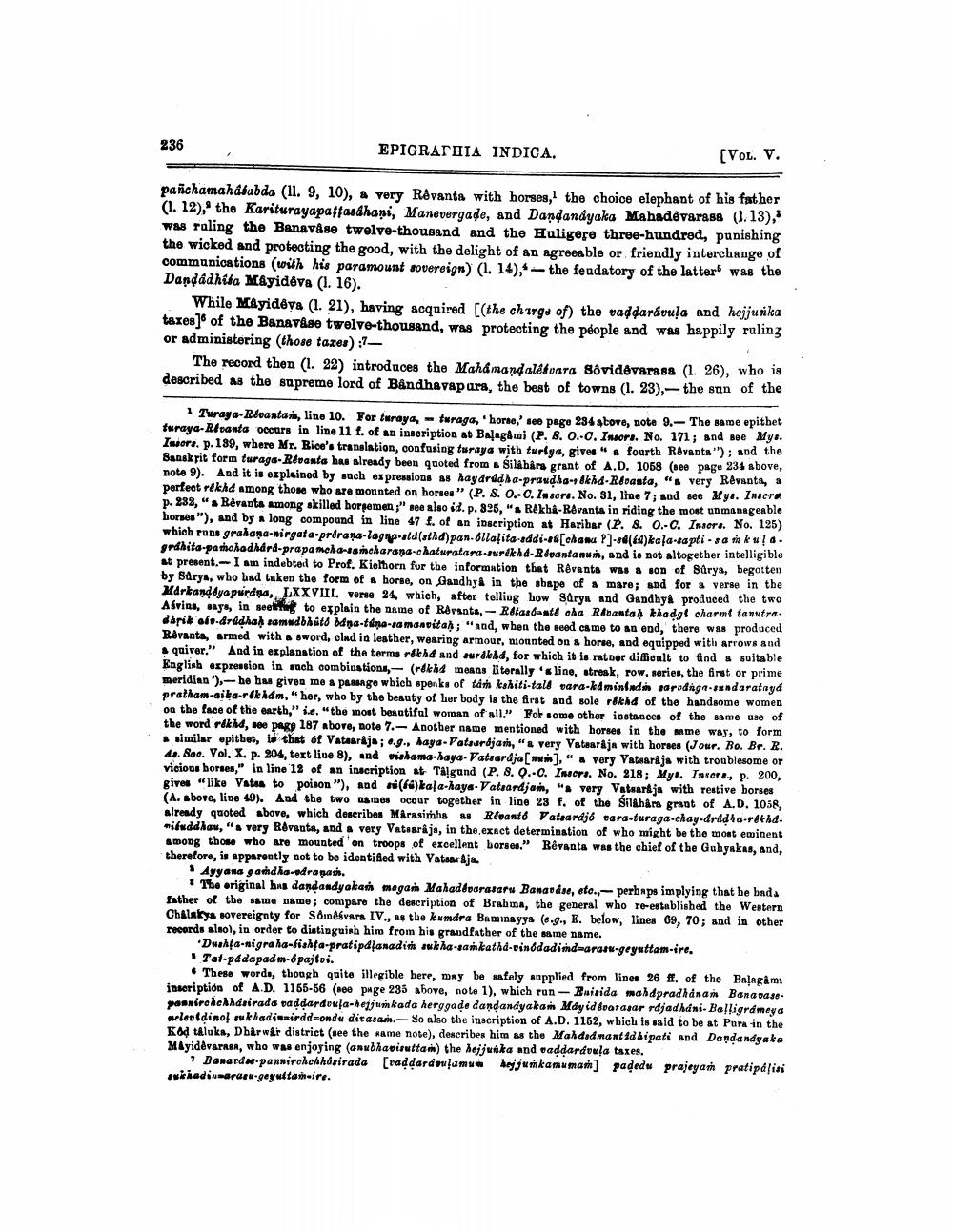________________
236
EPIGRATHIA INDICA.
(Vol. V.
panchamahababda (11. 9, 10), a very Rêvanta with horses, the choice elephant of his father (1. 12)," the Kariturayapaffasdhani, Manevergade, and Dandanayaka Mahadevarasa (1.13),' was raling the Banavåse twelve-thousand and the Huligere three-hundred, punishing the wicked and protecting the good, with the delight of an agreeable or friendly interchange of communications with his paramount sovereign) (1. 14), the feudatory of the latter was the Dandadhika M&yidéva (1. 16).
While Mayideva (1. 21), having acquired [(the charge of the vaddardvula and hejjunka taxes] of the Banavaso twelve-thousand, was protecting the people and was happily ruling or administering (those taxes):7
The record then (1. 22) introduces the Mahamandalesvara sôvidevarasa (1. 26), who is described as the supreme lord of Bandhavapura, the best of towns (1. 23), -the son of the
Turaya-Répantan, line 10. For turaya, - turaga, 'horse,' see pago 284 above, note 9.-The same epithet turaya-Répanta occurs in line 11 f. of an insoription at Balagui (P. B. 0. 0. Insors. No. 171; and see Mys. Insors. p. 189, where Mr. Bice's translation, confusing turaya with turlya, gives a fourtb Revants"); and the Banskrit form turaga-Révasta has already been quoted from a silában grant of A.D. 1058 (see page 234 above, noto 9). And it is explained by such expressions as hay dridha-prandha-kha-Répanta, "s very Revante, a perfect rikhd among those who are mounted on horses" (P. 8. 0...In sore. No. 81, line 7; and see Mye. Inser p. 282," Révanta among skilled hornemen;" see also id. p. 325,"RekbA-Ravanta in riding the most unmanageable horses"), and by a long compound in line 47 f. of an inscription at Harihar (P. 8. 0.-C. Insera. No. 125) which runs gralana.nirgata prirana lagnatd(sth) pan-ollalita addi- d[olan P] -d(84)ka a sapi.sakwa. grdhita-panchadhard-prapamohanlamcharana-chaturatara-surák hd-Répantanur, and is not altogether intelligible At present. I am indebted to Prof. Kieltorn fur the information that R@vanta was a son of Surya, begotten by Sarya, who had taken the form of horse, on Gandhya in the sbape of a mare; and for a verse in the Markanddya purana, LXXVIII. verse 24, which, after telling how Sarya and Gandhya produced the two Asvins, says, in seeking to explain the name of Röranta, - Ratasoanté cha Rdvantah khadgi charmi tanutradhpik aiv.drudhaḥ samudbhato odna-tdna-samanvitah; "and, when the seed came to an end, there was produced Beranta, armed with a sword, clad in leather, wearing armour, monnted on a horse, and equipped with arrows and
quiver." And in explanation of the terms rekha and ordkhd, for which it is rat per difficult to find a suitable English expression in such combiostions, (rékhd means literally 'slino, atresk, row, series, the first or prime meriding'), he has given me a passage which spenks of táto kahiti-tal vara-kd miniadis sarodige sandarataya pratham-aita-rik dm, "her, who by the beauty of her body is the first and sole rdkhd of the handsome women on the face of the earth," se. "the most beautifal woman of all." For some other instances of the same use of the word rokhd, see pape 187 above, note 7.- Another name mentioned with horses in the same way, to form
similar epithet, is that of Vataarija; .9., haya-Vatsurdjaris, "very Vstearaja with horses (Jour. Bo. Br. R. 4. Soo. Vol. X. p. 204, text line 8), and viskama-haya-Vatrardja[]," a very Vatsaraja with troublesome or vicious borses," in line 12 of an inscription at Tálgund (P. 8. Q.-C. Insors. No. 218; Myt. Insers, p. 200, gives "like Vstas to poison"), and wi(fa) kala-haya-Vatrandjam," very Vatsarkja with restive borses (A. above, line 49). And the two names occur together in line 23 f. of the sillhåra graet of A.D. 1058, already quoted above, which describes Marasimhs as Répantó Vataardjó cara-turaga-chay-dridha-rikha. rifuddhau," very Rovanta, and a very Vatsaraja, in the exact determination of who might be the most eminent among those who are mounted on troops of excellent borse." Beranta was the chief of the Gohyukas, and, therefore, is apparently not to be identifed with Vatoardja.
Ayyana gandha-odrapanis.
* The original bus dandandy akas magan Mahadevarataru Banaråse, etc.,- perhaps implying that be bada father of the same name, compare the description of Brahma, the general who re-established the Western Chalaya sovereignty for Sivara IV., As the lundra Baminayys (.9., E. below, lines 69, 70; and in other records slao), in order to distinguish him from his grandfather of the same name.
Dwahţa-nigraha-fishta-pratipdlanadie sukha-sankathd-vinodadimd=arasu-geguttam-ire.
Tat-padapad m-6pajtoi.
• These words, though guite illegible bere, may be safely supplied from line 26 fl. of the Balagâm inscription of A.D. 1165-56 (100 page 235 above, note 1), which run-Buisida mahdpradhna Bananaseyannirode hasirada raddardowla-hajjunkada herggade dandandyakan Mdy idrarasar ndjad hdniBalligrameya weleoldinol mukhadinsirdd-ondu ditana. So also the inscription of A.D. 1162, which is said to be at Pars in the Kod taluka, Dharwår district (see the same note), describes him as the Maldadmantadhipati and Dandandyake MAyiddvarasa, who was enjoying (anubhaoisutta.) the hojjunka and vaddardvala taxes.
Benardspansirchchhasirada (raddardruļumu dejjunkamuman padedu prajeyam pratipáļisi sriiedinmaraew-geyultanire.




